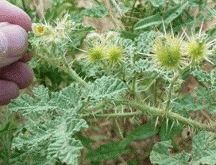NOXIOUS WEEDS ARE AN ‘EXPLOSION IN SLOW MOTION’
Published 12:00 am Friday, August 24, 2007

- Buffalo bur has spines 1/8 to 1/2-inch long. (Photo/Richard Old/www.xidservices.com).
– Mike McInnis
For The Observer
Weeds have been defined as "plants out of place."
Ralph Waldo Emerson said a weed is a "plant whose virtues have yet to be discovered.” Yet, some weeds are so harmful they have been declared "noxious" by federal and state laws.
Noxious weeds are of foreign origin and did not evolve in North America. Oregon State Revised Statutes declares plants "noxious" if they are "injurious to public health, agriculture, recreation, wildlife or any public or private property.”
The spread of noxious weeds in the U.S. began primarily in the mid-1800s when people migrated here from around the globe and accidentally or purposely brought plants with them from their home countries. These plants were not invasive in their home country because they evolved with pathogens, insect predators and other plants that kept them in check.
Such natural controlling factors were not present in North America when these foreign plants arrived and they became very aggressive and increased exponentially.
Rush skeletonweed is a good example. It is so named because it appears to have almost no leaves. It is in the sunflower family and is native to Eurasia. It was probably accidentally introduced as a contaminant in crop seed and was found in Banks, Idaho, in 1954. By 1964 there were 40 acres; today there are more than 4 million acres of rush skeletonweed in Idaho.
The spread of noxious weeds has been called "an explosion in slow motion.” There are more than 250 species on the Oregon noxious weed list. These plants don’t respect property boundaries and are found in forests, rangelands, cropland, wetlands, cities and towns. It has been estimated that more than 8.5 million acres of federal lands alone are infested and weeds increase at a rate of about 14 percent per year. That rate translates to about 4,600 acres per day!
Noxious weeds are a problem because they compete with crops and native plants, reducing biodiversity and hindering wildlife habitat and recreation They increase the incidence of soil erosion and wildfire. Noxious weeds reduce forage for livestock and big game. Some are toxic and can poison animals.
Most noxious weeds are unsightly and can form solid monocultures, taking over huge areas. A large ranch near Klamath Falls was abandoned in 1989 because it was dominated by leafy spurge. The ranch sold for less than 10 percent of its original value and was taken off the tax rolls the following year.
A study conducted by North Dakota State University found direct and indirect losses due to leafy spurge totaled $87.3 million annually on North Dakota grazing lands.
Oregon statutes give counties authority to establish weed boards to identify and manage weeds within that county. The Union County Weed Board has identified nearly 30 noxious weeds in the county.
Class "A" weeds are those of limited distribution within the county and are of the highest priority to eradicate. Examples are leafy spurge, whitetop and buffalo bur.
Class "B" and "C" weeds are more widespread and too abundant to make eradication feasible. The goal in managing these weeds is to contain them, reduce populations where they exist and prevent invasion into uninfested areas. Examples are yellow starthistle, diffuse knapweed and sulfur cinquefoil.
An important mission of the Union County Weed Board is to help county residents learn about noxious weeds so they can identify and control them where they exist and take measures to prevent their spread.
The weed board prioritizes noxious weeds using four weed management criteria: 1. invasive ability and threat level; 2. confirmation of presence and estimated area affected; 3. potential to eradicate and/or contain population; and 4. effectiveness of biological control.
Noxious weeds currently rated as top priority include knapweeds, yellow starthistle, leafy spurge, meadow hawkweed, dalmation toadflax, sulfur cinquefoil and whitetop.
The purpose of the rating system is to provide an official guideline for implementing noxious weed control programs in Union County, and assist the county in the distribution of available funds as specified.
The weed board is actively seeking the involvement of new partners to network with.
"The Back Country Horsemen and Forest Capital have signed on and we look forward to working together to protect our resources,” said Nancy Dake, who chairs the weed board.
This past winter Jennie Tucker of the weed board spoke with me about a possible educational publicity project involving students in the OSU Agriculture Program. The idea blossomed into a special one-credit course given in the spring titled, "Ecology and Management of Rangeland Noxious Weeds."
Several students, all seniors majoring in Rangeland Ecology and Management, took the course. The final project was a short paper on noxious weeds of Union County. Students conducted independent research on a weed of their choice. Their articles will be published as space allows in the coming days.
The students and I all felt the course was a success. We hope readers of The Observer feel the same. Noxious weeds are not simply a problem of agricultural lands. They affect us all. They diminish natural ecosystems and wildlife habitat. Together, we must work to limit their spread.
The first step is for us to learn to recognize noxious weeds and take measures to prevent the spread of seeds. We hope these articles help.
/>
Mike McInnis is a professor in the OSU Agriculture Program at Eastern Oregon University

